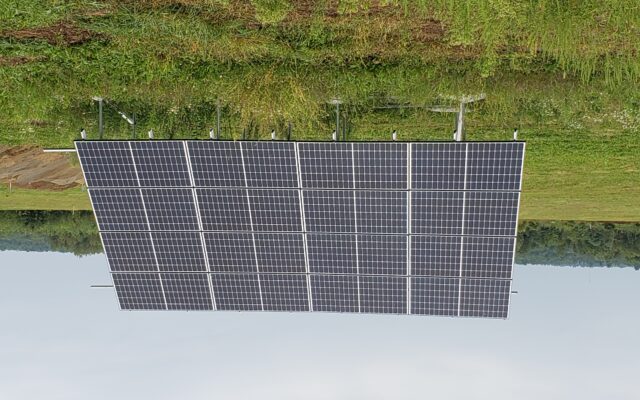
Community solar program will cost Mainers $220M a year by 2025
Rep. Foster’s bill would eliminate net energy billing
By Mehr Sher, Bangor Daily News Staff
Maine’s public advocate warned the Maine Legislature on April 13 the costs of community solar programs for electricity customers are likely to explode in the coming years.
Community solar projects, which are funded by passing costs on to nonsubscribers through their electricity bills, are expected to cost electricity customers $220 million a year by 2025, with the increase continuing for the next 20 years, Maine Public Advocate Bill Harwood said in his testimony on LD 1347. Those rising costs could potentially harm Maine’s goal to reduce fossil fuel dependence.
The bill, sponsored by Rep. Steven Foster, R-Dexter, would eliminate net energy billing, which provides discounts on electricity bills for those who subscribe to community solar farms. The savings for subscribers, however, are not absorbed by utilities or solar developers. Rather they are passed on to electricity customers who don’t participate in community solar.

By 2025, Harwood estimated that an average Maine electricity customer could expect to pay up to $275 a year due to the state’s current community solar policies. The money could subsidize the creation of 1,200 megawatts of power in Maine, representing more capacity than any generator in New England, even the Seabrook and Millstone nuclear plants, Harwood said.
While Harwood said net energy billing for community solar is flawed and should be changed, he has reservations about ending it altogether. Instead of asking people to subscribe to solar farms, he recommended that the Maine Public Utilities Commission set up a competitive bidding program for smaller solar projects, resulting in long-term power purchase agreements between utilities and winning solar developers.
Harwood testified “neither for nor against ” the bill.
In the past, net energy billing was mostly used for rooftop solar panels to offset costs for homeowners through the production of excess power. But under 2019 legislation, this rate structure also was applied to community solar farms to further incentivize them and prompt similar benefits for participants.
Community solar projects are smaller scale and typically sell power to nearby residential and commercial properties. They are supposed to allow people to participate in solar even if they don’t install panels on their property.
But the arrangement has been criticized because the costs that customers pick up to fund community solar programs, called stranded costs, are not necessarily based on customers’ power consumption or line maintenance costs for utilities. These costs also are not always clearly defined on electricity bills.
Versant Power specifically lists stranded costs on customers’ electricity bills. Central Maine Power doesn’t specify stranded costs as a line item, but they are included in the overall delivery charges on its electricity bills.
“The biggest driver of the rise in stranded costs are the net energy billing programs for community solar,” Harwood said.
Stranded costs are the vehicle through which energy policies, such as those for community solar programs, are funded.
“Funding public policy through electricity rates is a regressive way to do it,” said Phil Bartlett, the chair of the utilities commission. “The issue is that the magnitude of the cost that we’re seeing over a very short period of time is going to lead to significant increases in the costs of electricity bills.”
These costs did not exist until utilities were restructured more than 20 years ago. Since 2000, utilities can no longer generate electricity and are responsible only for transmitting and distributing electricity. This is when the Legislature created stranded costs, which were used to pay the utilities that lost assets as a result of the restructuring.
Today, utilities are concerned about the rising costs of electricity bills due to stranded costs funding community solar incentives.
“We are concerned that if we keep putting the cost of these programs into stranded costs it will raise electricity bills such that it is unaffordable for people,” said Judy Long, the communications manager for Versant Power.
The solar industry in Maine doesn’t agree that the program will make electricity unaffordable. They say that it would be damaging to pass LD 1347.
“I think that this $220 million per year by 2025 estimate for the subsidy is an exaggeration and ignores the value that these projects provide to the grid and ultimately to all consumers, including those of whom may not choose to be community solar subscribers,” said Jeremy Payne, the executive director of the Maine Renewable Energy Association and a lobbyist.
He said that the net energy billing program will not grow to a point where it creates significant hardships for consumers.
“If I were the commission, or the public advocate, I would be encouraging people to sign up for community solar, especially if they’re concerned about not receiving the benefits from the program,” he said.
Others said it would be more equitable to fund energy policies, such as the one for community solar, through taxes instead of charging all utility customers regardless of their income. Many lower-income Mainers are skeptical about community solar programs and are unlikely to sign up for them, but they will end up paying for the programs as the stranded costs get added to their electricity bills.
“From a social justice perspective, it can be argued that it would be more equitable through taxes, but we do know that legislators don’t like to raise taxes,” said Richard Silkman, an expert on the regulation of utilities, the founder of GridSolar LLC and a founding partner of Competitive Energy Services, an energy consultancy.
Customers don’t necessarily understand the different components of their electricity bills, but they are frustrated with increasing bills.
“I think the average consumer doesn’t care about the components of the bill or what kind of costs. They are only focused on the amount due at the bottom of the bill, and they expect all of us in the state government and the utilities to make electricity more affordable,” Harwood said.